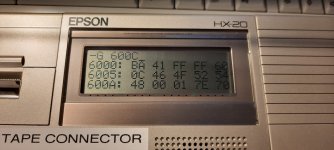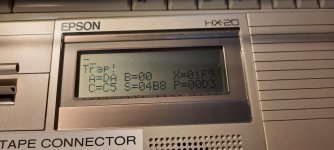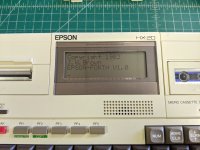Well thank you guys, all of this is very helpful. So it is good to know that the ROM is indeed supposed to work from 0x6000 on. I am having some issue with my Expansion Unit that provides up to 16 KBs of RAM and 2 EPROMs (either 2764 or 27128 it seems), and I don't seem to be able to see the ROMs there with the monitor.
So I unplugged the external expander (as I did before), and only have the stock HX-20 with the internal option ROM = FORTH in 11E, so this is 0x6000 to 0x7FFF, and I am able to see the "right bytes" from the FORTH.BIN image there, so it is definitely not "memory mapping / paging" related. I can also execute a G 600C (the Startaddress) and get the same Trap!
So next I'll wait for the 1.0 OS / BASIC, that should hopefully fix that issue then, right? Unless the Forth really needs 16 or 8 KB RAM expansion, but that shouldn't be the case, as Geoff already explained.
Btw, my expansion module is the one described here; I tried different configurations as explained. But the Forth needs to be in 11E or 13B in the Expander, if I understand
https://fjkraan.home.xs4all.nl/comp/hx20/memoryMap.html
correctly. With the 2nd config (13B) with DIP switches OFF ON ON OFF A A for that config, I can't read the proper bytes from 0x6000 on with the monitor via D. Which makes me suspicious (maybe the Expander doesn't like my EPROMS somehow).
Hence, I am using stock HX-20 now, with FORTH = 11E, as it should be. Screenshots of the monitor and G 600C in that config. You can see that it correctly reads the first bytes from the FORTH.BIN ROM, so this config is definitely good:





